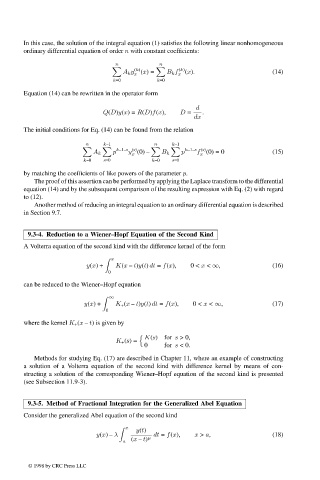Page 485 - Handbook Of Integral Equations
P. 485
In this case, the solution of the integral equation (1) satisfies the following linear nonhomogeneous
ordinary differential equation of order n with constant coefficients:
n n
(k) (k)
A k y (x)= B k f x (x). (14)
x
k=0 k=0
Equation (14) can be rewritten in the operator form
d
Q(D)y(x)= R(D)f(x), D ≡ .
dx
The initial conditions for Eq. (14) can be found from the relation
n k–1 n k–1
k–1–s (s) k–1–s (s)
p y (0) – p f (0) = 0 (15)
A k B k
x x
k=0 s=0 k=0 s=0
by matching the coefficients of like powers of the parameter p.
The proof of this assertion can be performed by applying the Laplace transform to the differential
equation (14) and by the subsequent comparison of the resulting expression with Eq. (2) with regard
to (12).
Another method of reducing an integral equation to an ordinary differential equation is described
in Section 9.7.
9.3-4. Reduction to a Wiener–Hopf Equation of the Second Kind
A Volterra equation of the second kind with the difference kernel of the form
x
y(x)+ K(x – t)y(t) dt = f(x), 0 < x < ∞, (16)
0
can be reduced to the Wiener–Hopf equation
∞
y(x)+ K + (x – t)y(t) dt = f(x), 0 < x < ∞, (17)
0
where the kernel K + (x – t)isgiven by
K(s) for s >0,
K + (s)=
0 for s <0.
Methods for studying Eq. (17) are described in Chapter 11, where an example of constructing
a solution of a Volterra equation of the second kind with difference kernel by means of con-
structing a solution of the corresponding Wiener–Hopf equation of the second kind is presented
(see Subsection 11.9-3).
9.3-5. Method of Fractional Integration for the Generalized Abel Equation
Consider the generalized Abel equation of the second kind
x y(t)
y(x) – λ µ dt = f(x), x > a, (18)
a (x – t)
© 1998 by CRC Press LLC
© 1998 by CRC Press LLC
Page 467

